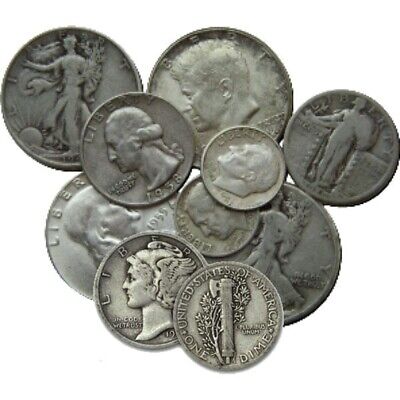The current prices and values for the silver coins below, 90%, 40%, and 35% are calculated using today’s spot silver price.
| Today’s Silver Spot Price |
|---|
| $72.79 |
90% Silver Coin Values
| 90% Silver Coin | Face Value | Silver Weight | Today’s Melt Value |
|---|---|---|---|
| 90% Silver Dime | 10 cents | .07 troy oz | $5.1 |
| 90% Silver Quarter | 25 cents | .17875 troy oz | $13.01 |
| 90% Silver Half-Dollar | 50 cents | .3575 troy oz | $26.02 |
| 90% Silver Dollar | 1 dollar | .7735 troy oz | $56.3 |
40% Silver Coin Values
| 40% Silver Coin | Face Value | Silver Weight | Today’s Melt Value |
|---|---|---|---|
| 1965-1970 Kennedy Half-Dollars | 50 cents | .147893 troy oz | $10.77 |
| 1971-1976 Eisenhower 40% Silver Proofs | 1 dollar | .3161 troy oz | $23.01 |
35% Silver Coin Values
| 35% Silver Coin | Face Value | Silver Weight | Today’s Melt Value |
|---|---|---|---|
| War Nickels | 5 cents | .0563 troy oz | $4.1 |
What is “Junk Silver”?
Junk Silver is a term that describes old, circulated silver coins valued primarily for their silver content rather than their collectible or numismatic value. Despite the term “junk,” these coins hold significant value due to their precious metal content.
Junk silver coins offer a practical way to invest in precious metals, combining affordability with silver’s intrinsic value. These coins remain popular with investors, whether for investment or as a hedge against economic instability.
The term “junk” does not indicate the condition of the coins but signifies that their value is derived primarily from their metal content rather than any collectible or face value. These coins have no significant numismatic or collector value above their bullion content.
US Mint Pre-1965 Silver Coins
During the 1965 debasement, many people began hoarding silver coins because they were more valuable than copper-clad ones.
This follows the economic principle of Gresham’s Law, which states that “bad money drives out good.”
90% of junk silver coins are easily recognizable and frequently traded among bullion dealers, investors, and those seeking a reliable store of value.

Mercury & Roosevelt Dimes,
Washington & Standing Liberty Quarters,
JFK & Frankling Half-Dollars
Prior to 1965, dimes, quarters, half dollars, and one-dollar coins were made from a 90% pure silver alloy.
Today, these coins are a store of value sold by coin dealers, antique dealers, pawn shops, and online precious metals dealers, often at a slight premium over their melt value.
Due to their ease of liquidity, they are recognizable and frequently traded among bullion dealers, investors, and preppers.
Silver dollar coins, notably the Morgan Silver Dollar and the Peace Silver Dollar, are often included only in junk silver if they are very worn, damaged, or considered in cull condition. Collectors are usually willing to pay a premium for antique silver dollar coins.
How much is junk silver worth?
The tables above illustrate today’s melt values using the current spot silver price.
The value of these coins comes from the intrinsic value of the amount of silver each coin contains. The word “Junk” refers only to the coins not having any value for collectors. Junk Silver is not considered scrap.
In the United States, dollar, half-dollar, quarter, and dime coins minted before 1965 contained 90% silver.
Is 90% Silver a Reliable investment?
Investing in precious metals is an excellent way to save money for a rainy day. It provides more stability for saving cash than putting money into a savings account with a bank.
Buying Junk Silver is also a top priority for those preparing for disaster, whether financial or societal collapse. Junk Silver is real money. Each coin is fractional silver that can be used for trade and barter.
Before buying junk silver, you must familiarize yourself with the various types. Having some basic knowledge, such as which years’ coins were minted with silver and which ones weren’t, will help prevent you from making major mistakes when you buy junk silver.
The most common junk silver coins will also have the lowest premium over the silver spot price. The two most common coins you’ll find for junk silver are the Roosevelt Dime and the Washington Quarter.
Calculating 90% Junk Silver Values
Junk silver bags come in various face-value bags from online bullion dealers. Most dealers will carry $10 Face Value bags, $50 Face Value bags, $100 Face Value bags, and $1,000 Face Value bags.
When first minted, a $100 Face Value bag of 90 percent silver coins would contain 72.3 troy ounces of silver. Through average circulation, the coins will have some natural wear and tear that causes a slight amount of silver to wear away. It’s generally accepted that a $100 Face Value bag of junk silver coins today will contain roughly 71.5 troy ounces of silver.
Types of Junk Silver
Before 1965, many coins in the United States were minted from an alloy containing 90% silver. Many coins from this time are collected and have numismatic value in addition to their intrinsic metal value.
Circulated coins minted before 1965 that contain 90% silver and have little to no numismatic value to collectors are commonly referred to as junk silver.
For US Coinage, there are three basic types of Junk Silver:
- 90% Silver – Dollar coins, half-dollars, quarters, and dimes minted prior to 1965.
- 40% Silver – Kennedy Half-dollar coins minted from 1965 until 1969.
- 35% Silver – Nickel coins minted during specific years of World War II, from 1942 until 1945.
In 1965, the US Mint and Treasury departments began minting coins made from clad copper. Of those minted before 1965, dimes, quarters, half dollars, and dollar coins were minted in 90% silver. From 1965 until 1970, Kennedy Half Dollars were minted in an alloy containing 40% silver.
From 1942 until 1945, “War Nickels” were minted in an alloy of 35% silver.